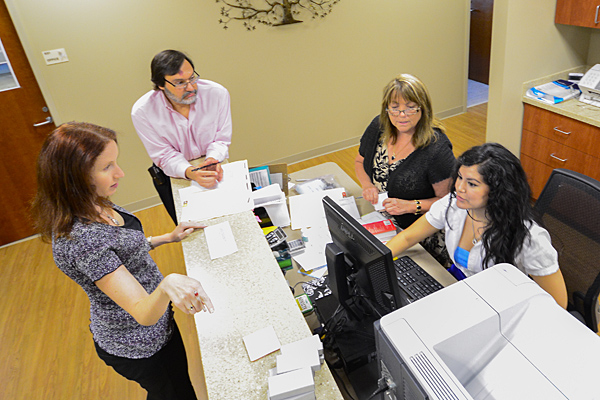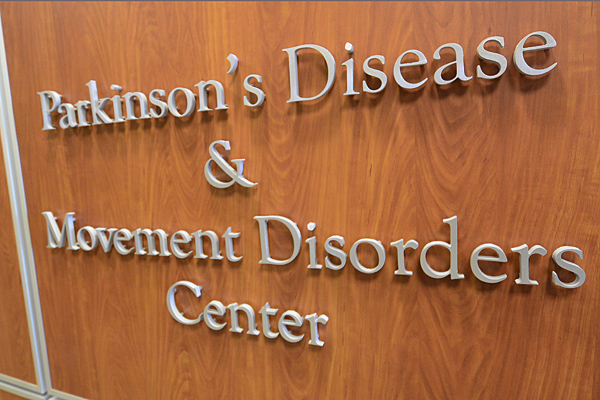Earlier this year, the USF Parkinson’s Disease and Movement Disorders Center moved from Harbourside Medical Tower on the Tampa General Hospital campus into its new home on the sixth floor of the USF Health Byrd Alzheimer’s Institute.
The relocation nearly doubled the center’s space to nearly 5,700 square feet — adding a larger waiting area, extra exam rooms, and a comfortable infusion room where clinical trial patients receiving intravenous medications can be monitored.
“It’s given us much-needed room to provide care for more patients and expand our research efforts,” said Center Director Robert A. Hauser, MD, MBA, USF Health professor of neurology and molecular pharmacology and physiology, who has led the center since 1994.
There are two other centers where leading USF Health neurologists see patients with Parkinson’s disease and other movement disorders, and offer clinical research opportunities. Theresa Zesiewicz, MD, FAAN, directs the USF Parkinson’s Disease and Balance Center at the Morsani Center for Advanced Healthcare and oversees the Frances J. Zesiewicz Foundation for Parkinson’s Disease. Juan Sanchez-Ramos, MD, PhD, is medical director of the Parkinson Research Foundation Center of Excellence at USF and sees patients at both the Morsani Center and at Parkinson Place in Sarasota.

Dr. Robert Hauser, director of the USF Parkinson’s Disease and Movement Disorders Center, with some of the center’s staff, outside their new space on the sixth floor of the USF Health Byrd Alzheimer’s Institute.
Both Dr. Hauser and David Morgan, PhD, CEO of the USF Health Byrd Alzheimer’s Institute, agree that co-locating scientists and clinicians specializing in Parkinson’s disease with specialists in Alzheimer’s disease and other forms of dementia is beneficial from both a research and clinical perspective.
Though both are progressive diseases of the nervous system, at first glance Parkinson’s and Alzheimer’s may not appear to have much in common.
The symptoms of Parkinson’s – a movement disorder characterized by tremors, muscle rigidity and slowness — seem to concentrate more on physical disability, while Alzheimer’s afflicts memory and other mental abilities. Yet, about half of all people with Parkinson’s develop some form of dementia in the later stages of the disease. And, the motor and physical skills of patients with Alzheimer’s disease often deteriorate as the disease advances.

Dr. Hauser checks the reflexes of patient Betsy Barber.
“It’s a very natural fit to bring experts in these two neurodegenerative diseases together under one roof,” Dr. Morgan said. “The underlying processes leading to Parkinson’s disease and Alzheimer’s disease – the accumulation of abnormal proteins in the brain resulting in the death of nerve cells — may be more alike than different.”
“There is a fair amount of overlap,” Dr. Hauser said. “If we can figure out how to attack and slow the progression of one disease, I think it could tell us a lot about how we might attack and slow the progression of the other.”
“In addition, we want to collaborate with investigators here at the Byrd Institute to try to improve our understanding of dementia in Parkinson’s disease and develop better therapies for patients with thinking and memory problems.”

The PET/CT scanner used for clinical research and assistance in diagnosing dementia at the Byrd Alzheimer’s Institute is one of the many resources available to patients of the Parkinson’s Disease Center.
In addition to more opportunities for research collaboration in the laboratory and the clinic, other advantages of the co-location were noted:
- Adding physician expertise — Since some patients with Alzheimer’s disease may eventually develop motor symptoms and those with Parkinson’s may eventually experience cognitive decline, it is convenient for patients and their families to have clinicians trained in each specialty at the same site.
- Expanded access to clinical trials – The USF Parkinson’s Disease and Movement Disorders Center has established a comprehensive, nationally-recognized clinical trials program, and the Byrd Institute’s clinical trials program continues to strengthen. In addition to leveraging patient-oriented research that may help in understanding and managing both diseases, clinicians have access to more trials for which their interested patients may be eligible.
- Leveraging shared resources – These include a PET/CT scanner used for clinical research and assistance in diagnosing dementia in the Byrd Institute’s Center for Memory C.A.R.E. There are opportunities for expanded use of this equipment with the development of new imaging techniques incorporating radiopharmaceutical agents to help diagnose Parkinson’s disease and related movement disorders. Other resources like the Byrd Institute’s driving simulator, mini-apartment to test ability of patients to live on their own, and caregiver library and information center will also be available to patients of the Parkinson’s Center.

Barber, diagnosed with Parkinson’s 11 years ago, has participated in several clinical trials offered by the USF center.
More than the spacious, visually appealing surroundings at the new venue, patients appreciate the medical and support staff’s expertise at the USF Parkinson’s Disease Center, which is designated one of only 43 National Parkinson’s Foundation Centers of Excellence worldwide.
“USF is on the forefront of all the new knowledge and treatments for Parkinson’s disease,” said Betsy Barber, 68, a retired nurse who was diagnosed with Parkinson’s 11 years ago. “I want those latest research advances available to me as a patient.”
Barber says she is doing well on an extended-release medication that helps ameliorate a deficiency of dopamine, the brain chemical depleted as Parkinson’s slowly destroys the nerve cells producing it. She started on the investigational drug while participating in a clinical trial at USF several years ago, and it has since been approved by the U.S. Food and Drug Administration and is commercially available.
“It takes 10 to 15 years to bring a new drug to market,” Barber said. “If you’re enrolled in a study here you get it right away, plus you receive an incredible work-up and a lot of ongoing support from Dr. Hauser and his entire staff.”

Tom Curran, a local Fox-13 news anchor, says the center’s multidisciplinary team works with him to fine-tune a medication regimen that helps him remain active.
Tom Curran, a local Fox-13 News anchor, has been a patient of the USF Parkinson’s Center for more than five years. For Curran, Parkinson’s started as an index finger twitch as he rested his hand on the steering wheel – a movement so subtle that his wife pointed it out during a car ride.
At USF, he found a multidisciplinary team that worked with him to identify and fine-tune a successful treatment regimen. It’s helped him maintain a demanding work schedule, which requires rising several hours before he begins anchoring the weekday morning news at 5 a.m.
“Dr. Hauser’s team has done a tremendous job of prescribing the right medicine in the right amount for me,” Curran said. “They always seem ready for the next challenge here. If something wears off, they find something else to put into the mix.”
The medication Curran takes – Stalevo – is just one of several newer anti-Parkinson’s drugs that were tested at USF. In fact, Dr. Hauser led an international study of patients with early Parkinson’s disease that demonstrated Stalevo provided better symptom control and more improvements in activities of daily living than Sinemet (carbidopa/levadopa), the most widely used treatment for patients.

A third of scientists at the USF Health Byrd Alzheimer’s Institute, including Kevin Nash, PhD, (pictured) are working on research related to Parkinson’s disease as well as Alzheimer’s.
The Center has also been at the forefront of evaluating a new extended-release version of carbidopa/levadopa, known as (IPX066), that alleviates motor symptoms quickly and appears to last longer than other levodopa medications currently available. The drug is expected to be approved by the FDA next year.
“USF has been involved in investigating almost every new therapeutic for Parkinson’s disease that’s come to market in the last 20 years,” Dr. Hauser said.
The Center’s clinical research encompasses not only drug studies, but new surgeries and innovative cell-based therapies that may offer hope for patients who no longer benefit from drug therapy. USF was one of first institutions to participate in trials of deep brain stimulation surgery for the treatment of Parkinson’s and essential tremor.
In recent years, USF researchers have turned their attention to trying to improve the non-motor symptoms of Parkinson’s, such as fatigue and apathy, cognitive dysfunction, anxiety, falls and sleep disorders. Studies have shown these non-motor symptoms contribute to disability and can impair a patient’s quality of life as much, or more than, motor symptoms.

They are also looking for ways to identify those at high risk for Parkinson’s as early as possible so that the degenerative brain disorder can ultimately be stopped or slowed.
For example, research has shown that loss of smell and rapid eye movement (REM) behavior disorder, a sleep disorder characterized by acting out dreams with punching, grabbing, kicking or other jerky movements, may be early indicators of Parkinson’s, emerging well before motor symptoms become apparent.
“We’re placing increasing emphasis on finding people with a decreased sense of smell or who are hitting and kicking in their sleep, because they may already have early Parkinson’s disease and will develop slowness, stiffness and tremor in the future,” Dr. Hauser said. “They are the ones we want to bring into clinical trials to try new medications that may slow the disease and prevent motor symptoms before they begin.”

Click here for some highlights of the center’s research, patient care and outreach.
Photos by Eric Younghans and video by Danielle Barta, USF Health Communications
